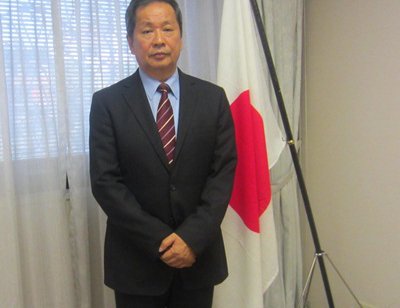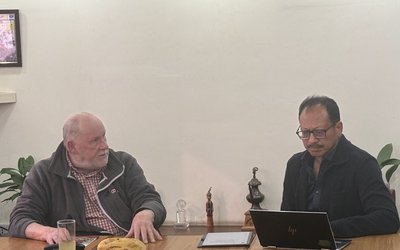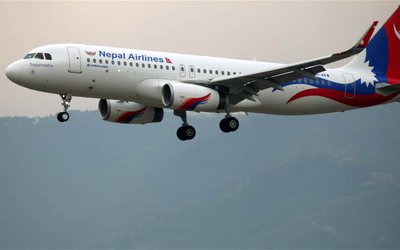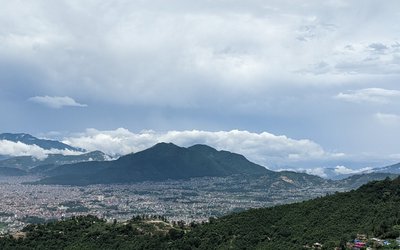
This year, we are celebrating the 60th anniversary of the Nepal-Japan diplomatic relationship. How do you view and assess the past and the present of our relationship?
September 1st, 2016 is the very 60th anniversary of the establishment of the diplomatic relationship between Japan and Nepal. First of all, on behalf of the people and the Government of Japan, I would like to express my deepest appreciation to the countless people who have contributed to the promotion of the friendly relationship of our two countries.
The year 1956 was a time when Japan and the Japanese people rose up again from agony and chaos that resulted from the defeat in WWII, in order to start a new nation-building. At the same period, in Nepal, Ranacracy had come to an end and B.P. Koirala started democratic reform. Japan and Nepal had had contacts with each other in such episodes as the Rev. Ekai Kawaguchi’s religious and adventurous visit to Tibet via Nepal in 1900 and the Rana regime’s dispatch of eight Nepalese students to Japan in 1902. It is on the very September 1st 1956 when Japan and Nepal, as sovereign states, established their formal diplomatic relationship. Both Japan and Nepal were at the starting point of a new nation-building in the new world order after WWII, when they established the diplomatic relationship. The year 1956 was also the year when the world’s first-ever conquest of Manaslu by a Japanese team exalted the spirit of the Japanese people, who had been defeated in WWII. Nepal is engraved deeply in our heart by this historic event, too.
For the past six decades, the world witnessed various upheavals, changes and developments. During the period, Japan, having advanced as a member of the free-market, western bloc, has been making various contributions commensurate with its economic might, to the stability and prosperity of the world including Asia, as a responsible member of the international community. On the other hand, Nepal, too, having experienced several major changes of its political regimes, has steadily advanced on the path to democratization and development. As of 2016, Japan and Nepal share such common ideas as free society, democracy, peaceful resolution to international conflicts. We also share common stances on most of important international issues. Japan and Nepal now enjoy a friendly and collaborative relationship, which is the best ever, based upon the multi-facetted mutual interactions that took place in the past in such areas as business/economy, culture, and education.
How do you expect our bilateral relationship to evolve in the future?
The current relationship between Japan and Nepal is the one between a donor and an aid recipient, while we enjoy an amicable diplomatic relationship and a comfortable people-to-people friendship. We cannot say that the amounts of our bilateral trade and investment are satisfactorily big. The Government of Japan wishes to further develop our bilateral relationship so that our two counties will become mutually beneficial partners in the private business sector, too.
Nepal is a land-locked country without a seaport. Due to the geographical reality of Nepal that 85% of its territory is mountainous, the building of transportation routes has been delayed and Nepal lacks much plain lands suitable to establish a major industry. Nepal’s hydropower resources, regarded as among the world’s biggest, are yet to be fully developed, diverse agricultural products of Nepal are not competitive in spite of their potentials, due to insufficient transportation infrastructure and the lack of facilities to conduct primary processing. Nepalese economy is sustained by the huge amount of remittance from three million migrant workers. It seems to us that Nepal has yet to find a sustainable economic growth and development model which fits Nepal best.
The Japanese have an experience from the end of the 19th century to the first half of 20th century that we have succeeded to develop an economically backward country into a country able to work and compete with Western powers. As Japan has reconstructed itself from the ashes of WWII, we have transformed ourselves from a recipient of foreign aid into its provider. As we will continue to assist the Government of Nepal and work with the people of Nepal for Nepal’s socio-economic development, we would like to try to find, with our Nepalese friends, a development model which shall work for Nepal.
For the past decades, Nepal has experienced several changes of political regimes. How have such changes influenced the Nepal-Japan relationship?
Since 1948, when Padma Shumsher Jung Bahadur Rana promulgated a constitution after WWII, up to September 2015, seven constitutions, including interim ones, were promulgated in Nepal. This clearly shows that in Nepal there took place several major changes of the political regimes.
However, the friendship between Japan and Nepal has never been damaged by such changes on the side of Nepal. The Japanese and Nepalese royal families had a long-standing amity. Even after the phasing out of the monarchy in Nepal on 2008, Japan and Nepal further deepened their relationship. To help the Nepal peace process after the end of the insurgency, the Government of Japan dispatched Self Defense Force personnel to UNMIN and two election monitoring teams to the April 2008 and November 2013 Constituent Assembly elections. Regardless of the Nepalese political systems, Japan has always been the “true friend of Nepal” and will remain so in the future.
The promulgation of the first democratically drafted constitution in September 2015 was an extremely important milestone for Nepal. The Government of Japan has welcomed and celebrated the promulgation and enforcement of this constitution. For this constitution to be better implemented, Nepal needs to establish a political and administrative system in which to properly reflect people’s will and grievances. The Government of Japan, believing the wisdom of the people of Nepal, would like to implement any necessary assistance as much as possible in this regard.
How are Nepal and Japan celebrating the 60th anniversary?
At the beginning of this year, the Government of Japan, in consultation with the Government of Nepal, decided on the 60th anniversary logo and commissioned Yuichiro Miura, a prominent Japanese alpinist, as the 60th anniversary friendship ambassador. The Government of Japan has already held, and will organize, various cultural events including a Japanese cultural festival, a Jazz concert by a famed Japanese musician, in partnership with several Japan-Nepal friendship organizations. On the very day of the 60th anniversary, September 1st, with the presence of Japanese and Nepalese dignitaries, a grandeur official memorial ceremony will be held. It is my sincerely hope that a variety of events to be held throughout this year further promote the already amicable bilateral relationship.
How do you assess the current status of the people-to-people interaction between Nepal and Japan? As the two countries are celebrating the 60th anniversary, the number of the Japanese visitors is continuously decreasing. How do you analyze this trend?
People-to-people interactions between Japan and Nepal are actually becoming even heavier and busier these years. According to a statistics on March 2016, the number of the Nepalese people staying in Japan is around 55,000, ranking 6th among all the countries and areas. The number of the Nepalese students in Japan also increased to around 16,000 according to a recent survey, ranking 3rd only below Chinese and Vietnamese.
The number of visitors from Japan to Nepal truly decreased from 25, 829 in 2014 to 17,613 in 2015. We think this was caused mainly by the reduction of the number of tourists due to the April 2015 earthquake, which seems to be only a transient phenomenon. I wish more foreign, including Japanese, tourists to come back to Nepal responding to tourism promotion initiatives to be taken by the Government of Nepal and the Nepalese tourism industry, which shall make best use of Nepal’s rich tourism resources including the Himalayas.
Today, Nepal is in the process of reconstruction from its devastating earthquake disaster. Please explain Japan’s supports to Nepal in response to the earthquake.
First of all, Japan and Nepal, who suffered from great earthquake disasters last and this year, have further deepened their cordial relationship since then by extending mutual assistance.
To respond to the April 25th, 2015 earthquake, partnering with the Government of Nepal and other donors, the Government of Japan has been making its best efforts to implement as much work as possible toward early reconstruction of the lives of the Nepalese people. Immediately after the earthquake, as the emergency humanitarian assistance, the Government of Japan provided emergency assistance supplies to the Government of Nepal and a set of emergency grant assistances (USD14million) to eight international agencies. Three Japanese rescue/medical teams (264 members in total) were dispatched to Nepal. Following on those emergency responses, Japan has been implementing the recovery and reconstruction assistance with the JPY 32 billion projects (or USD 260 million, which is the third largest among state donors, next only to India and China) for the recovery and reconstruction of housing, schools, public facilities/infrastructures and cultural heritages. Currently, we are working for reconstruction in various sectors, closely working with the National Reconstruction Authority and other line Ministries. In addition, our experts and volunteers dispatched from Japan are providing the people of Nepal with Japanese expertise and technologies to fight against earthquake disasters.. Under the “Emergency Housing Reconstruction Project” and the “Emergency School Reconstruction Project”, both of which are funded by the Government of Japan, the reconstruction works started for the earthquake-damaged houses in Gorkha and Sindhupalchowk districts this April and for schools in Lalitpur this May respectively.
When a big earthquake hit Kumamoto, Japan on April 14 this year, I received many heart-warming messages from many Nepalese leaders and citizens. I also noticed a news report in Japan that Nepalese residents in Japan served Nepalese curry for Japanese evacuees at temporary shelters in Kumamoto. I am very pleased to realize that taking the opportunities of those earthquake disasters in the two countries, our mutual help and gestures further solidified our bond.
We believe that DRR (Disaster Risk Reduction) measures, if properly strengthened and implemented, could minimize casualties and damages resulting from future earthquakes in Nepal. As “true friends” of Nepal, the people of Japan, who have experienced numerous natural disasters themselves, strongly wish the minimization of earthquake disasters to materialize in Nepal. The Government of Japan is determined to expedite its reconstruction works and to continue to support the “Build Back Better” of Nepal.
Since the establishment of diplomatic relationship between Japan and Nepal, Japan has been providing various supports to Nepal for the sake of uplifting the living standard of Nepalese people. How do you evaluate the outcomes of those supports?
Since 1954, when Japan joined the Colombo Plan, as a main donor to Nepal, we have been providing its assistance to many sectors of Nepal and have made significant achievements in poverty reduction, uplifting living standard and socio-economic development as a whole. These achievements were made possible by the collective and arduous efforts of the Government of Japan and JICA and of NGOs and private volunteers at the grassroots level. If I may introduce Japan’s past aid figures, we have extended JPY 205 billion in grant aid, JPY 105 billion in loans and JPY 75 billion in technical cooperation. We have also dispatched 2,600 experts and 1,300 volunteers and have accepted 5,500 trainees from Nepal.
Let me note several achievements in the social infrastructure sector. To start, “Kulekhani Hydropower” and “Kathmandu-Bhaktapur Road” have significantly uplifted the living standard of the people of Nepal. In March, 2015, we completed the “Sindhuli Road (or B.P. highway) Construction Project”. This road is improving regional connectivity and enhancing the livelihood of local residents in its areas adjacent to the road by offering an improved market access. Adding to these completed projects, we are currently working on such new projects as “Tanahu Hydropower Project”, “Melamchi Water Supply Project” and “Tribhuvan International Airport (TIA) Modernization Project”.
Now, we are planning to start the “Project for Improvement of Aviation Safety Facilities in Major Airports” to improve aviation safety at TIA and other selected major regional airports. We are also preparing to launch such new projects as construction of a traffic tunnel, a water-supply system and healthcare facilities. Japan will continue to advance many projects in various sectors for the sake of Nepal’s development.
Please explain Japan’s supports to Nepal’s social sectors such as education and health and the outcomes of those supports.
Japan’s support toward poverty reduction in Nepal has not been limited to the aforementioned hard infrastructure development, but also been extended to various soft infrastructures.
In the education sector, Japan has for a long-time supported Nepal through many projects such as school construction (10,800 classrooms from 1994 up to 2011), technical cooperation for improved school management and dispatching Japanese experts to the Ministry of Education. In addition, we started providing a budgetary support to the Ministry of Education in 2014, in order to reform Nepal’s school sector. The 7-year-long “SSRP (School Sector Reform Plan)”, implemented at the initiative of the Ministry of Education of Nepal and with the cooperation of many donors including Japan, has significantly improved the quantitative access to education as shown in the improved figures on enrolment and remaining rates in primary and secondary education and on female students’ participation in education, to pick a few. From now on, we need to work more on improving the “quality of education (or the quality of students’ learning)” than before.
Japan has also assisted Nepal’s health sector for a long period. We constructed Tribhuvan University Teaching Hospital (TUTH), Kanti Children’s Hospital, and National Tuberculosis Center. Our assistance also includes the provision of technical cooperation for improved nutrition and the dispatch of volunteers, who are health professionals. In this fiscal year, we plan to sign an E/N with the Government of Nepal to provide TUTH with additional medical equipment, based on a preparatory study conducted last year. The Government of Japan will continue its cooperation in Nepal’s health sector in order to upgrade Nepal’s medical techniques.
Japan has also been supporting Nepal’s agriculture and livelihood sectors. Please explain Japan’s supports to those sectors and their outcomes.
In the agriculture sector, the Government of Japan and JICA conducted such technical transfers as instructing local farmers on vegetable-farming, introducing value-added commodity products, introducing fish-farming of rainbow trout. As a result, several rural villages succeeded in generating additional income. Young people or other potential workforce in these villages are more likely to stay at home, as they now do not have to work overseas for income. Japan’s technical cooperation on water management in mountainous areas prompted the villagers to utilize the local resources efficiently and led to revitalizing those areas. The Government of Japan plans to continue its assistance to Nepal’s agriculture sector, as there still is a room for more improvement to add to the apparent returns from the past projects.
What do you think would be the most important for the future of Nepal?
Contemplating Nepal’s future development, I particularly expect highly-motivated persons of the younger generations to be more proactive. The Government of Japan introduced the “Japanese Grant for Human Resource Development Scholarship” (JDS) to Nepal in this fiscal year. Through this scheme, the Government of Japan will sponsor twenty promising Nepalese government officials every year to obtain a master’s degree in development-related areas at Japanese universities. I get excited when I imagine how these young and promising officials, who have studied in Japan, would work vigorously for Nepal’s future development.
Will Japan’s valuable financial and technical supports to Nepal, which have been provided for the development of various sectors during the past 60 years, last in the future as well?
Nepal is a country rich in such resources as hydropower, tourism destinations (including the Himalayas and other world heritages), and enduring and diligent labor force. For Nepal to graduate from the LDC status, Nepal obviously needs to stabilize its domestic politics, develop its basic infrastructure, to make best use of its rich resources, thus to invite quality foreign direct investments.
Japan, as the “true friend” of Nepal, is determined to continue its cooperation in various sectors in addition to assistance for reconstruction from the earthquake. We will also uphold the efforts of the Government of Nepal toward Nepal’s socio-economic development after the promulgation of its new constitution.

Keshab Poudel
Poudel is the editor of New Spotlight Magazine.
- FOURTH PROFESSOR Y.N. KHANAL LECTURE: Nepal-China Relations
- Jun 23, 2025
- Colonel JP CROSS: Centenary Birthday
- Jun 23, 2025
- REEEP-GREEN: Empowering Communities with MEP
- Jun 16, 2025
- BEEN: Retrofitted For Green
- May 28, 2025
- GGGI has been promoting green growth in Nepal for a decade: Dr. Malle Fofana
- May 21, 2025















